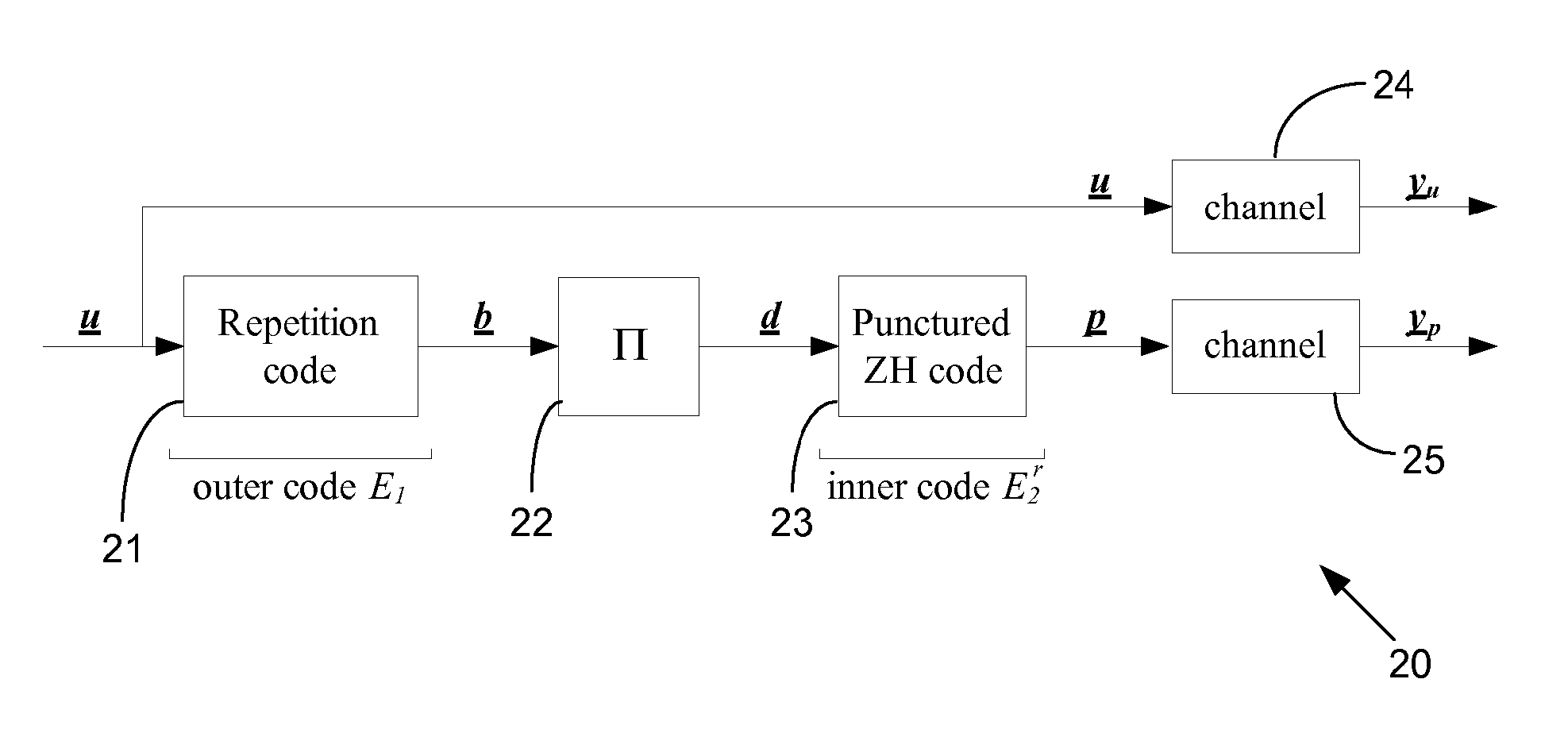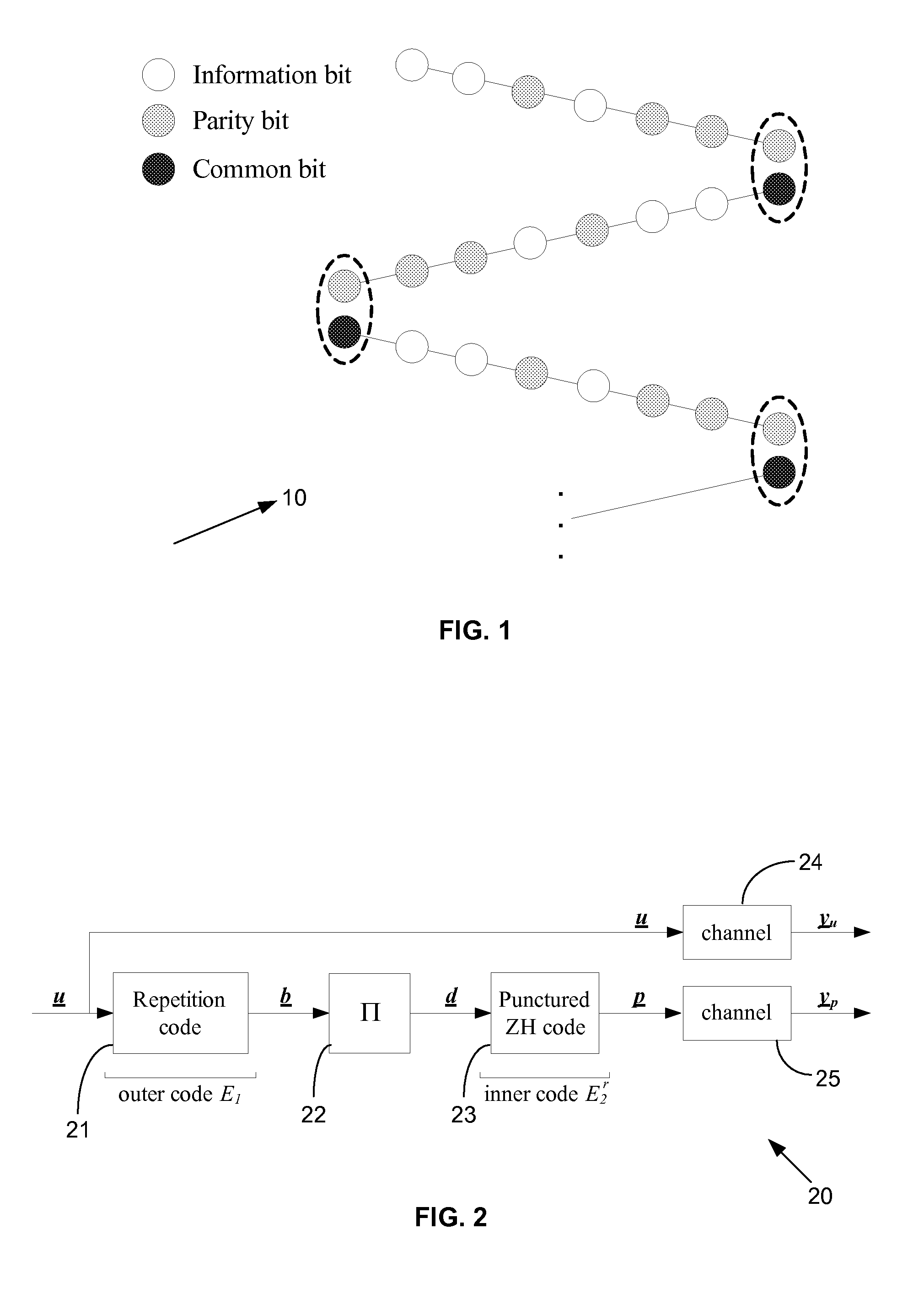Low-Complexity High-Performance Low-Rate Communications Codes
a low-rate, high-performance technology, applied in the field of low-complexity high-rate communication codes, can solve the problems of large performance loss from simulation, high cost, and high cost, and achieve the effect of reducing the convergence speed of iterative decoding, and reducing the complexity of the cod
- Summary
- Abstract
- Description
- Claims
- Application Information
AI Technical Summary
Problems solved by technology
Method used
Image
Examples
example 1
[0060] Consider first an un-punctured regular RZH code with r=4 and dv=14 which results in a coding rate of around 0.018. FIG. 9 plots 90 the EXIT chart of this code, from which it can be seen that the corresponding SNR threshold is around −0.05 dB. Now consider the irregular code with dv=14 whose degree profile polynomial is given by f(x)=0.323x3+0.175x8+0.026x22+0.476x23. The corresponding EXIT chart for Eb / N0=−0.98 dB is also plotted in FIG. 9, where the solid line denotes the EXIT function of the outer mixture repetition codes with the optimized profile and diamond denotes the EXIT function of the inner ZH code.
[0061]FIG. 10 plots 100 the simulated BER results of the regular and irregular un-punctured RZH codes with an information block length of 65536 and a maximum iteration number of 150. It is seen that with r=4, the un-punctured IRZH code has a gain of 0.71 dB (measured at Pb=10−4) over the regular code, whereas the gap to the capacity is around 0.8 dB. With larger r, bette...
example 2
[0062] Next we consider the performance of the systematic IRZH codes. Since the repetition bits are punctured, much better performance can be expected. Indeed, for r=4 and Rc=0.05 , a code with f(x)=0.467x3+0.375x10+0.158x11 has a theoretic SNR threshold of EbN0=-1.34 dB,
which is only 0.1 dB away from the capacity. The EXIT chart of the curve-fitting result is shown 110 in FIG. 11 and the BER performance is shown in FIG. 12. Results show that the simulated SNR threshold is −1.14 dB (only around 0.31 dB away from the capacity) which is much better than that of the un-punctured code with the same r and a much lower (0.0179) coding rate. FIG. 12 also depicts the BER performance of a lower rate code with r=4 and Rc=0.018 whose theoretical SNR threshold is EbN0=-1.42 dB
with f(x)=0.364x3+0.014x11+0.192x12+0.074x13+0.095x36+0.136x37+0.1087x38+0.004x39+0.013x200. The simulated SNR threshold of this code is around −1.2 dB, which is 0.34 dB away from the capacity and around 0.8 dB bet...
example 3
[0063] To see the difference between the systematic and nonsystematic codes, for r=4 and Rc=0.05, a nonsystematic code with f(x)=0.456x3+0.147x9+0.343x10+0.054x20 has a theoretical SNR threshold of EbN0=-1.43
dB, which is slightly better than that of systematic code. The BER performance of this code is shown 120 in FIG. 12 which shows a simulated SNR threshold of around −1.16 dB, with a small coding gain of 0.02 dB over its systematic counterpart. This is as expected since for nonsystematic IRZH codes, the systematic bits are further punctured and for the same rate, more parity bits can be transmitted.
Performance with Parallel Decoding
PUM
 Login to View More
Login to View More Abstract
Description
Claims
Application Information
 Login to View More
Login to View More - R&D
- Intellectual Property
- Life Sciences
- Materials
- Tech Scout
- Unparalleled Data Quality
- Higher Quality Content
- 60% Fewer Hallucinations
Browse by: Latest US Patents, China's latest patents, Technical Efficacy Thesaurus, Application Domain, Technology Topic, Popular Technical Reports.
© 2025 PatSnap. All rights reserved.Legal|Privacy policy|Modern Slavery Act Transparency Statement|Sitemap|About US| Contact US: help@patsnap.com



